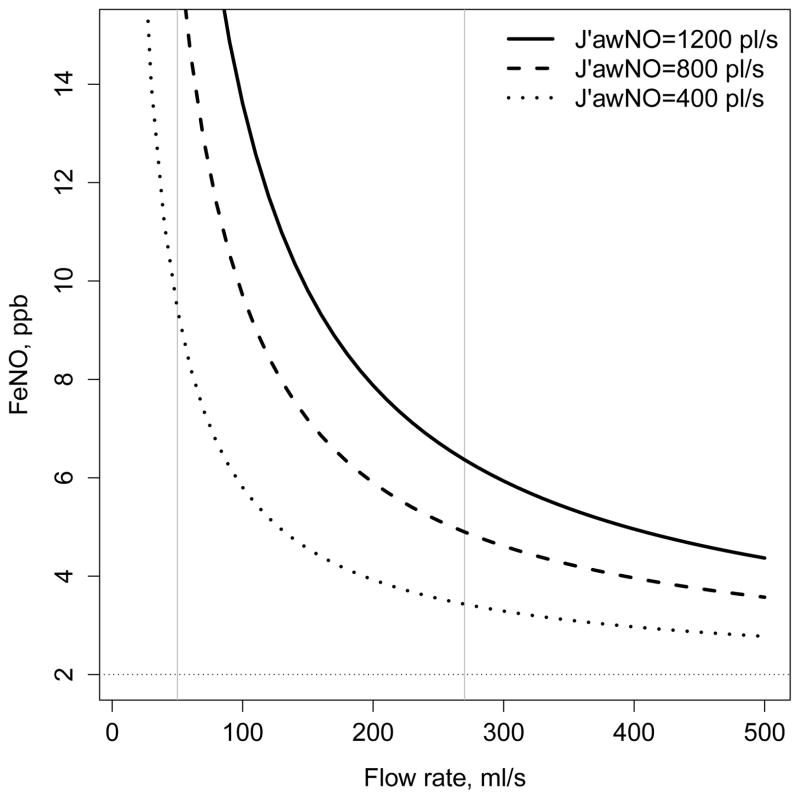The fractional concentration of exhaled nitric oxide (FeNO) has been used as a non-invasive biomarker of airway response to inhaled toxic exposures in both population-based and occupational studies. Results have been mixed, but a compelling finding is the 60% decrease (95% confidence interval (CI): 54, 66) and subsequent 130% increase (95% CI: 63, 225) in FeNO observed in a quasi-experimental study of FeNO in a group of healthy young adult volunteers before, during, and after the 2008 Beijing Olympic games air pollution control measures.[1] Methodological developments now allow for assessment of NO from proximal and distal airway compartment sources. The ability to non-invasively differentiate inflammation in two lower respiratory tract compartments may provide a practical method to gain insights into the effects of inhaled toxins. Using this approach, Sauni et al found that occupational silica exposure was significantly associated with increased distal (i.e., alveolar) NO but not with conventionally assessed FeNO.[2] One could also, for example, assess the differential effects of coarse and fine/ultrafine particulate matter air pollution on the proximal and distal airway compartments using this method. It is possible to partition FeNO into proximal and distal sources because feNO is flow rate dependent, with high flow FeNO providing more information about distal/alveolar sources and low flow FeNO providing more information about proximal/airway sources. Using statistical models, it is possible to estimate parameters representing airway and alveolar sources from a simple two-compartment model of NO exchange in the lower respiratory tract (CaNO: alveolar NO concentration, J’awNO: maximum airway flux, and DawNO: airway tissue diffusing capacity).[3] However, we have noted a trend of using FeNO assessed at a single high flow rate as a proxy for alveolar NO, as early as Barregard et al 2008.[4 5] Authors using this method have been careful to interpret FeNO at 270 ml/s (FeNO270) as representing “to a higher extent than FeNO50…NO derived from the distal airways.”[4] To quantitatively assess the performance of FeNO270 as a proxy for CaNO, we performed a simple theoretical experiment using statistical simulations by generating FeNO—without error—from the two-compartment model using identical values for CaNO and DawNO but different values for J’awNO. Figure 1 shows that important differences in FeNO270 can occur solely due to differences in J’awNO. We conclude that high flow FeNO is an imperfect proxy for CaNO. When using high flow FeNO to study effects of exposures (e.g., air pollution) or disease on distal NO, differences in proximal NO (J’awNO) may substantially contaminate the association of interest. A straightforward remedy would be to measure FeNO at multiple flow rates and use an appropriate statistical model to estimate CaNO. Standard guidelines have been developed by the American Thoracic Society and European Respiratory Society for the assessment of single flow FeNO, at the conventional 50 ml/s flow rate, so FeNO50 is widely investigated in research studies and is being increasingly considered in clinical practice. As of yet, there is no guideline for multiple flow FeNO assessment, so compartmental NO is primarily being used in research studies.
Figure 1.
FeNO as a function of flow, from a two-compartment model where CaNO=2 ppb and DawNO = 5 pl ·s−1·ppb−1.
Footnotes
Competing interests None.
References
- 1.Huang W, Wang G, Lu SE, et al. Inflammatory and Oxidative Stress Responses of Healthy Young Adults to Changes in Air Quality during the Beijing Olympics. Am J Respir Crit Care Med. 2012 doi: 10.1164/rccm.201205-0850OC. rccm.201205-0850OC [pii] [DOI] [PMC free article] [PubMed] [Google Scholar]
- 2.Sauni R, Oksa P, Lehtimäki L, et al. Increased alveolar nitric oxide and systemic inflammation markers in silica-exposed workers. Occupational and environmental medicine. 2012;69(4):256–60. doi: 10.1136/oemed-2011-100347. [DOI] [PubMed] [Google Scholar]
- 3.George SC, Hogman M, Permutt S, et al. Modeling pulmonary nitric oxide exchange. J Appl Physiol. 2004;96(3):831–9. doi: 10.1152/japplphysiol.00950.2003. [DOI] [PubMed] [Google Scholar]
- 4.Barregard L, Sallsten G, Andersson L, et al. Experimental exposure to wood smoke: effects on airway inflammation and oxidative stress. Occup Environ Med. 2008;65(5):319–24. doi: 10.1136/oem.2006.032458. [DOI] [PubMed] [Google Scholar]
- 5.Modig L, Dahgam S, Wass K, et al. Effects of short-term exposure to air pollution on the levels of exhaled nitric oxide among adults – Results from the ADONIX study in Gothenburg, Sweden. Eur Respir J. 2012;40(s56):609s. [Google Scholar]



